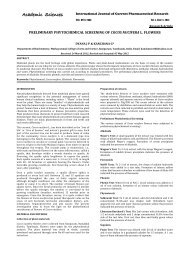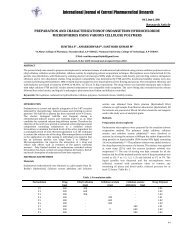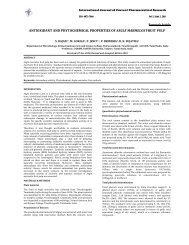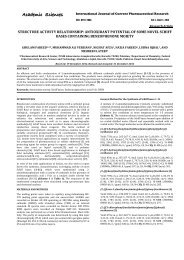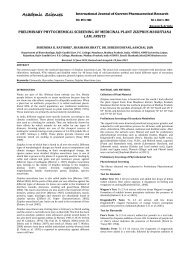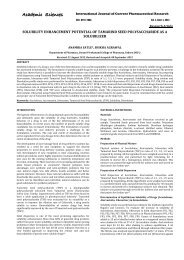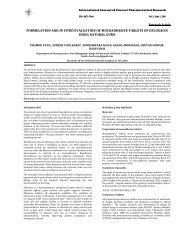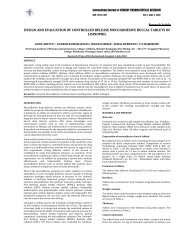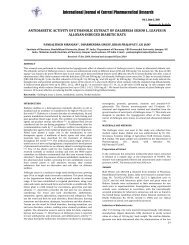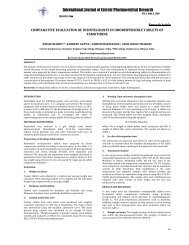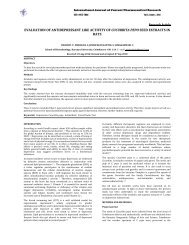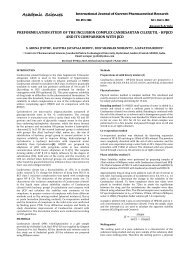formulation and evaluation of oral controlled drug delivery system for ...
formulation and evaluation of oral controlled drug delivery system for ...
formulation and evaluation of oral controlled drug delivery system for ...
You also want an ePaper? Increase the reach of your titles
YUMPU automatically turns print PDFs into web optimized ePapers that Google loves.
International Journal <strong>of</strong> Current Pharmaceutical ResearchISSN- 0975-7066 Vol 3, Issue 2, 2011Research ArticleFORMULATION AND EVALUATION OF ORAL CONTROLLED DRUG DELIVERY SYSTEM FOR AMODEL ANTI DIABETIC DRUG METFORMINJALPA R. PATEL* 1 BHAVIK A. PATEL 1 , DIPIKA G. PATEL 1 , DARPINI S. PATEL 1 , VINA B. PATEL 1K.J.College <strong>of</strong> Pharmacy, Vadasma, Mehsana Gujarat Email: pharmajalpa2007@yahoo.comReceived: 26 Sep 2010, Revised <strong>and</strong> Accepted: 29 Oct 2010ABSTRACTMet<strong>for</strong>min is poorly water soluble <strong>drug</strong>, so solubility is the main constraint <strong>for</strong> <strong>oral</strong> its bioavailability. An attempt has been made to increase thesolubility <strong>of</strong> this model <strong>drug</strong> by <strong>for</strong>mulating Matrix tablet Hydroxylpropyl methylcellulose (HPMC), Ethyl cellulose <strong>and</strong> PVP <strong>and</strong> Carbopol‐934polymer to control the release <strong>of</strong> <strong>drug</strong> with a view to develop Controlled release dosage <strong>for</strong>m. Tablet <strong><strong>for</strong>mulation</strong>s were prepared by directcompression technique <strong>and</strong> were evaluated <strong>for</strong> Precompression <strong>and</strong> post compression parameters. Among different <strong><strong>for</strong>mulation</strong>s <strong>of</strong> directcompression containing <strong>drug</strong> is to polymer ratio 1:2 gives best dissolution pr<strong>of</strong>ile <strong>and</strong> dissolution efficiency <strong>and</strong> among tablet <strong><strong>for</strong>mulation</strong>s F1, F4,F11 Dissolution pr<strong>of</strong>iles compared with other <strong><strong>for</strong>mulation</strong>s. Results showed that Hydroxylpropyl methylcellulose (HPMC) <strong>and</strong> Ethyl cellulose ispromising polymer <strong>for</strong> enhancing the solubility <strong>of</strong> met<strong>for</strong>mine. They are found to be with good physical integrity, free from any <strong>drug</strong>‐polymerinteraction <strong>and</strong> the results provided a method <strong>of</strong> achieving <strong>controlled</strong> <strong>drug</strong> action through uni<strong>for</strong>m <strong>drug</strong> release.Keywords: ‐ Met<strong>for</strong>min HCl, HPMC E‐5O, Carbopol ‐934, Ethyl cellulose <strong>and</strong> PVP Controlled release.INTRODUCTIONThe goal <strong>of</strong> any <strong>drug</strong> <strong>delivery</strong> <strong>system</strong> is to provide a therapeuticamount <strong>of</strong> <strong>drug</strong> to the proper site <strong>of</strong> the body, to promptly achieve<strong>and</strong> then maintain the desired therapeutic <strong>drug</strong> concentration thatelicits the desired pharmacological action <strong>and</strong> to minimize theincidence <strong>and</strong> the severity <strong>of</strong> unwanted adverse effects. To achievethis goal, it would be advantageous <strong>and</strong> more convenient to maintaina dosing frequency to once, or twice‐daily regimen. An appropriatelydesigned extended release dosage <strong>for</strong>m can be a major advance inthis direction compared to conventional immediate release dosage<strong>for</strong>m. The development <strong>of</strong> improved method <strong>of</strong> <strong>drug</strong> <strong>delivery</strong> hasreceived a lot <strong>of</strong> attention in the last two decades 1, 2 .Among varioustechnologies available, monolithic matrices‐matrix tablets continueto be popular because <strong>of</strong> simple processing technologies required,reproducibility, <strong>and</strong> stability <strong>of</strong> the materials <strong>and</strong> dosage <strong>for</strong>m aswell as ease <strong>of</strong> scale‐up operation.In particular, the interest awakened by matrix type deliveries iscompletely justified in view <strong>of</strong> their biopharmaceutical <strong>and</strong>pharmacokinetics advantages over the conventional dosage <strong>for</strong>ms.These are release <strong>system</strong>s <strong>for</strong> delay <strong>and</strong> <strong>controlled</strong> release <strong>of</strong> a <strong>drug</strong>that is dissolved or dispersed in a resistant support todisintegration. During the last two decades swelling polymers arebeing used as sustained or <strong>controlled</strong> release devices 3, 4 . Met<strong>for</strong>mineis a third generation <strong>oral</strong> hypoglycemic <strong>drug</strong> used to treat type IIdiabetes mellitus. It has shown high anti‐diabetic activity <strong>and</strong> is veryeffective in type II diabetes mellitus in addition to low toxicity.However, Met<strong>for</strong>mine is practically insoluble in aqueous fluids, <strong>and</strong>as such its <strong>oral</strong> absorption is dissolution rate limited. There<strong>for</strong>e, itdisplays poor solubility in GI fluids, which results in low <strong>and</strong> erratic<strong>oral</strong> bioavailability. It was selected as a model <strong>drug</strong> <strong>for</strong> dissolutionenhancement studies in the present investigation. Attempts weremade to enhance the dissolution <strong>of</strong> Met<strong>for</strong>mine using a DCtechnique 5, 6, 7 .MATERIAL AND METHODMet<strong>for</strong>min hydrochloride was obtained from Strides Acro labs Ltd,Bangalore. , HPMC‐E50, Ethyl cellulose, Povidone, Carbopol‐934were obtained S. D. Fine Chemicals Ltd.Direct compressionThe <strong>drug</strong> <strong>and</strong> excipients were passed through sieve no. 60 prior tothe preparation <strong>of</strong> the dosage <strong>for</strong>m. The entire ingredients wereweighed separately <strong>and</strong> mixed thoroughly <strong>for</strong> 10 minutes to ensureuni<strong>for</strong>m mixing in geometrical ratio. The tablets were prepared bydirect compression technique using 10 mm punch in 10‐stationrotary machine; Rimek Machine.Bulk density (Db)It is a ratio <strong>of</strong> mass <strong>of</strong> powder to bulk volume. The bulk densitydepends on particle size distribution, shape <strong>and</strong> cohesiveness <strong>of</strong>particles. Accurately weighed quantity <strong>of</strong> powder was carefullypoured in to graduated measuring cylinder through large funnel <strong>and</strong>volume was measured, which is called initial bulk volume. It isexpressed in gm/ml <strong>and</strong> is given by Db = M / V0 Where, M is themass <strong>of</strong> powder, V0 is the bulk volume <strong>of</strong> the powder.Tapped density (Dt)Ten gram <strong>of</strong> powder was introduced into a clean, dry 100 mlmeasuring cylinder. The cylinder was then tapped 100 times from aconstant height <strong>and</strong> the tapped volume was read. It is expressed ingm/ml <strong>and</strong> is given by, Dt = M / Vt Where, M is the mass <strong>of</strong> powder.TVs is the tapped volume <strong>of</strong> the powder.Angle <strong>of</strong> repose (θ)It is defined as the maximum angle possible between the surface <strong>of</strong>the pile <strong>of</strong> the powder <strong>and</strong> the horizontal plane. Fixed funnel methodwas used. A funnel was fixed with its tip at a given height ‘h, above aflat horizontal surface to which a graph paper was placed. Powderwas carefully poured through a funnel till the apex <strong>of</strong> the conical pilejust touches the tip <strong>of</strong> the funnel. The angle <strong>of</strong> repose was thencalculated using following equation, θ = Tan 1 (h/r) Where θ =Angle<strong>of</strong> repose, h=Height <strong>of</strong> pile, r=Radius <strong>of</strong> the base <strong>of</strong> the pile.Carr’s Consolidation Index (I)Carr’s index is an indication <strong>of</strong> the compressibility <strong>of</strong> a powder. It isexpressed in percentage <strong>and</strong> is given by I = Dt – Db / Dt x 100 WhereDt=Tapped density, Db=Bulk density.Thickness <strong>and</strong> diameterControl <strong>of</strong> physical dimensions <strong>of</strong> the tablet such as thickness <strong>and</strong>diameter is essential <strong>for</strong> consumer acceptance <strong>and</strong> tablet uni<strong>for</strong>mity.The thickness <strong>and</strong> diameter <strong>of</strong> the tablet was measured usingVernier Calipers. It is measured in mm.HardnessThe Monsanto hardness tester was used to determine the tablethardness .The tablet was held between affixed <strong>and</strong> moving jaw. Scalewas adjusted to zero; load was gradually increased until the tabletfractured. The value <strong>of</strong> the load at that point gives a measure <strong>of</strong> thehardness <strong>of</strong> the tablet. It is expressed in kg/cm 2 .Friability (F)Tablet strength was tested by Roche friabilator. Pre weighed tabletswere allowed <strong>for</strong> 100 revolutions in 4 min <strong>and</strong> were dedusted. The
[Patel et al.Int J Curr Pharm Res, Vol 3, Issue 2, 3739percentage weight loss was calculated by reweighing the tablets. The% friability was then calculated by: ‐F =(Winitial) ‐ (Wfinal)(Winitial)X 100Weight variation as per IPR<strong>and</strong>omly selected twenty tablets were weighed individually <strong>and</strong>together in a single pan balance. The average weight was noted <strong>and</strong>st<strong>and</strong>ard deviation calculated. The tablet passes the test if not morethan two tablets fall outside the percentage limit <strong>and</strong> none <strong>of</strong> thetablet differs by more than double percentage limit. IP limit <strong>for</strong>weight variation in case <strong>of</strong> tablets weighting up to 120 mg is ± 10%,120 mg to 300 mg is ± 7.5% <strong>and</strong> more than 300 mg is ± 5%.PD= (Wavg) – (W initial) / (W avg) x 100Where PD= Percentage deviation, Wavg =Average weight <strong>of</strong> tablet,Winitial =Individual weight <strong>of</strong> tablet.Drug contentTablets equivalent to 100mg <strong>of</strong> <strong>drug</strong> were accurately weighed <strong>and</strong>transferred to 50ml volumetric flask. To this flask, sufficient amount<strong>of</strong> distilled water was added to dissolve the tablets completely. Then,the volume <strong>of</strong> flask was made up to the mark with same solvent.From this solution, 1ml <strong>of</strong> the sample was pipette out <strong>and</strong>transferred to 10 ml volumetric flask. The volume in the second flaskwas made up to the mark with distilled water. From this 0.6ml,0.8ml, <strong>and</strong> 1ml sample was withdrawn <strong>and</strong> volume was made up to10ml to maintain concentration within the beer’s range. This finaldiluted solution was estimated UV spectrophotometrically at232nm.In vitro Release studiesIn vitro dissolution studies <strong>for</strong> all the Matrix tablets were carried outusing USP type II Dissolution apparatus in 500 ml <strong>of</strong> phosphatebuffer (pH 6.8) as dissolution media, maintained at 37±0.5ºC at 50rpm. 0.5 ml aliquots were withdrawn at every 1 hour <strong>and</strong> replacedby 0.5 ml <strong>of</strong> fresh dissolution media (37ºC). The collected sampleswere analyzed after suitable dilution (if required) at 232 nm usingUV‐visible spectrophotometer against phosphate buffer (pH 6.8) asthe blank.RESULTS AND DISCUSSIONThe characterizations <strong>of</strong> different <strong><strong>for</strong>mulation</strong> were done <strong>for</strong>determination <strong>of</strong> mass‐volume relationship parameters. Theevaluated parameters are bulk density, tapped density,compressibility index, <strong>and</strong> angle <strong>of</strong> repose, Carr’s index shown intable 1.The bulk density <strong>of</strong> the powder <strong>for</strong> trial batch <strong>and</strong> also <strong>for</strong> optimized<strong><strong>for</strong>mulation</strong> <strong>of</strong> direct compression was in the range <strong>of</strong> 0.41‐to0.52gm/cc; the tapped density was in the range <strong>of</strong> 0.40 to0.56gm/cc, which indicate powder was not bulky. The angle <strong>of</strong>repose <strong>of</strong> the <strong>drug</strong> powder was in the range <strong>of</strong> 17 0 to 26 0 , whichindicate good flow <strong>of</strong> the powder, the Carr’s index was found to be inthe range <strong>of</strong> 3‐6 indicating compressibility <strong>of</strong> the tablet blend isgood.Table 1: Precompression parameter <strong>for</strong> direct compressionFormulation codeBulk density(gm/cm 3 )Tapped density(gm/cm 3 )Angle <strong>of</strong> repose( 0 )Carr’s index(%)F‐1 0.4274 0.4559 20.56 6.2513F‐2 0.4918 0.5152 18.57 4.5419F‐3 0.4612 0.4804 18.76 3.9966F‐4 0.4276 0.4090 17.87 4.3498F‐5 0.4108 0.4350 22.00 5.5686F‐6 0.4210 0.4432 21.06 5.0104F‐7 0.4373 0.4572 26.98 5.0246F‐8 0.4371 0.4644 25.70 5.8839F‐9 0.5263 0.5614 24.66 6.2522F‐10 0.4771 0.5070 23.54 5.9011F‐11 0.4713 0.5007 22.15 5.8905F‐12 0.4890 0.5195 25.65 5.8830F‐13 0.4236 0.4456 23.43 4.9371F‐14 0.4432 0.4701 24.23 5.7221Table 2: Postcompression parameter <strong>for</strong> direct compressionFormulation code Hardness(kg/cm 2 )Thickness (mm) Friability (%) Avg. WeightVariation (mg)F‐1 10 ± 0.3 6.56 ± 0.04 0.300 350 ± 2.12F‐2 10 ± 0.2 6.55 ± 0.03 0.315 349 ± 3.01F‐3 9 ± 0.2 6.51 ± 0.01 0.322 347 ± 2.55F‐4 10 ± 0.1 6.52 ± 0.03 0.278 354 ± 3.11F‐5 8 ± 0.2 6.55 ± 0.01 0.290 351 ± 3.41F‐6 8 ± 0.3 6.55 ± 0.03 0.321 355 ± 1.21F‐7 10 ± 0.2 6.56 ± 0.03 0.285 350 ± 2.12F‐8 9 ± 0.3 6.54 ± 0.05 0.311 351 ± 2.31F‐9 9 ± 0.2 6.51 ± 0.05 0.319 350 ± 3.43F‐10 8 ± 0.4 6.54 ± 0.02 0.292 354 ± 1.22F‐11 10 ± 0.2 6.53 ± 0.02 0.298 354 ± 1.19F‐12 10 ± 0.1 6.54 ± 0.04 0.322 353 ± 3.03F‐13 10 ± 0.2 6.55 ± 0.01 0.329 350 ± 1.32F‐14 8 ± 0.3 6.53 ± 0.02 0.300 352 ± 2 0738
Patel et al.Int J Curr Pharm Res, Vol 3, Issue 2, 3739The compressed tablets were tested <strong>for</strong> physical parameters likehardness, thickness, friability, weight variation evaluated <strong>for</strong> the<strong>drug</strong> content, in vitro <strong>drug</strong> release pr<strong>of</strong>iles <strong>and</strong> stability studies.Hardness, Thickness, Friability <strong>and</strong> Avg. weight variation <strong>of</strong> thetablet by direct compression were found to be 8‐10 kg/cm 2 <strong>and</strong>6.51‐6.56 mm, 0.27‐0.32% respectivey. Avg. weight variation <strong>of</strong> thetablet by direct compression was predicted that all the tabletsexhibited uni<strong>for</strong>m weight with low st<strong>and</strong>ard deviation values withinthe acceptable variation as per IP shown in table 2.Drug release studiesIn vitro dissolution studies were per<strong>for</strong>med <strong>for</strong> all the <strong><strong>for</strong>mulation</strong>susing USP type II tablet dissolution tester employing basket type at50 rpm using 500 ml <strong>of</strong> 0.1N HCl <strong>and</strong> 6.8 phosphate bufferdissolution medium. The samples withdrawn were analyzed byusing UV spectrophotometer. In direct compression, F1, F4, F11 areshown good <strong>drug</strong> release shown in figure (1& 2), F3 is shown less<strong>drug</strong> release may be due to the presence <strong>of</strong> PVP.Fig. 1: Dissolution study <strong>for</strong> direct compression (F 1 – F 7) Fig. 2: Dissolution study <strong>for</strong> direct compression (F 8 – F 14)CONCLUSIONBased on the Results <strong>and</strong> discussion, we can concluded thatControlled release tablets <strong>of</strong> Met<strong>for</strong>min HCl were preparedsuccessfully by direct compression using the combination <strong>of</strong>different concentration <strong>of</strong> polymers like HPMC‐E50, EC, PVP <strong>and</strong>carbopol‐934 <strong>and</strong> other excipients such as magnesium stearate aslubricant, talc as glident <strong>and</strong> lactose as diluent were found to begood without chipping, capping <strong>and</strong> sticking.REFERENCES1. Darshana HD, Mangal NS, Sudhakar GD. Design <strong>and</strong> <strong>evaluation</strong><strong>of</strong> an extended release tables <strong>of</strong> prochlorperazine maleate.Indian Drugs 2000; 38: 69‐74.2. Ravi kumar NMV, Pranita S, Dutta PK. Effect <strong>of</strong> swelling onchitosan‐amine oxide gel in extended release <strong>of</strong> <strong>drug</strong>. IndianDrugs 1999; 36: 393‐98.3. Turner S, Federici C, Hite M, Fassihi R. Formulationdevelopment <strong>and</strong> human in vitro‐in vivo correlation <strong>for</strong> anovel, monolithic <strong>controlled</strong> release matrix <strong>system</strong> <strong>of</strong> high load<strong>and</strong> highly water‐soluble <strong>drug</strong> niacin. Drug Development <strong>and</strong>Industrial Pharmacy 2004; 30:797‐07.4. Gul Majid Khan. Controlled release <strong>oral</strong> dosage <strong>for</strong>ms: Somerecent advances in matrix type <strong>drug</strong> <strong>delivery</strong> <strong>system</strong>s. TheSciences 2001; 1(5): 350‐54.5. Kabanov KV, Batrakova EV, AlakhovVY. Pluronic blockcopolymers as novel polymer therapeutics <strong>for</strong> <strong>drug</strong> <strong>and</strong> gene<strong>delivery</strong>. J Control Release 2002;82:189‐12.6. Frick A, Moller H, Wirbitzki E. In vitro/in vivobiopharmaceutical characterization <strong>of</strong> <strong>oral</strong> immediate release<strong>drug</strong> products. Comparison <strong>of</strong> phenoxymethylpenicillinpotassium, glimepiride <strong>and</strong> lev<strong>of</strong>loxacin. Eur J Pharm Biopharm1998;46:305‐11.7. Davis SN. The role <strong>of</strong> glimepiride in the effective management<strong>of</strong> type 2 diabetes. J Diabetes Complications 2004; 18:367‐76.39



